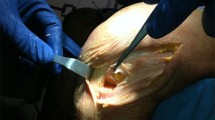Abstract
We compared antero-posterior translation and internal–external rotation of the tibia in stable knees without anterior cruciate ligament (ACL) injury with those of ACL injured knees using a navigation system and suggest an objective data. Forty-four patients treated for a meniscal tear without ACL injury were allocated to stable group, and 41 patients were allocated to ACL injury group. Antero-posterior displacement and rotation of knees were measured in 0, 30, 60 and 90 degrees of flexion using navigation. Mean anterior displacements were 3.6 ± 2.0, 6.7 ± 2.7, 6.0 ± 2.4 and 4.7 ± 1.8 mm at 0, 30, 60 and 90 degrees of flexion, respectively, in stable group, and 6.8 ± 3.6, 14.7 ± 3.5, 11.9 ± 4.6 and 8.5 ± 4.0 mm in ACL injury group. Mean total rotation values were 18.8 ± 4.5°, 31.4 ± 4.2°, 30.1 ± 5.1° and 29.2 ± 5.9° in stable group and 22.7 ± 6.9°, 37.6 ± 5.8°, 34.0 ± 9.4° and 31.8 ± 8.8° in ACL injury group. Quantitative values of antero-posterior translations and rotations of stable and ACL injured knees were obtained using a navigation system. The laxity data may be useful to establish the diagnosis of an ACL injury and evaluation of post-operative results.




Similar content being viewed by others
References
Markolf KL, Kochan A, Amstutz HC (1984) Measurement of knee stiffness and laxity in patients with documented absence of the anterior cruciate ligament. J Bone Joint Surg Am 66:242–252
Forster IW, Warren-Smith CD, Tew M (1989) Is the KT 1000 knee ligament arthrometer reliable? J Bone Joint Surg Br 71:843–847
Daniel DM, Malcom LL, Losse G, Stone ML, Sachs R, Burks R (1985) Instrumented measurement of anterior laxity of the knee. J Bone Joint Surg Am 67:720–726
Daniel DM, Stone ML, Sachs R, Malcom L (1985) Instrumented measurement of anterior knee laxity in patients with acute anterior cruciate ligament disruption. Am J Sports Med 13:401–407
Fu FH, Hamer CD, Johnson DL, Miller MD, Woo SL (1994) Biomechanics of knee ligaments: basic concepts and clinical application. Instr Course Lect 43:137–148
Lerat JL, Moyen BL, Cladière F, Besse JL, Abidi H (2000) Knee instability after injury to the anterior cruciate ligament. Quantification of the Lachman test. J Bone Joint Surg Br 82:42–47
Anderson AF, Snyder RB, Federspiel CF, Lipscomb AB (1992) Instrumented evaluation of knee laxity. Am J Sports Med 20:135–140
Bach BR, Warren RF, Flynn WM, Kroll M, Wckiewiecz TL (1990) Arthrometric evaluation of knees that have a torn anterior cruciate ligament. J Bone Joint Surg Am 72:1299–1306
Highgenboten CL, Jackson AW, Jansson KA, Meske NB (1992) KT-1000 arthrometer conscious and unconscious test results using 15, 20, and 30 pounds of force. Am J Sports Med 20:450–454
Mononen T, Alaranta H, Harilainen A, Sandelin J, Vanhanen I, Osterman K (1997) Instrumented measurement of anterior–posterior translation in knees with chronic anterior cruciate ligament tear. Arch Orthop Trauma Surg 116:283–286
Isberg J, Faxen E, Brandsson S, Eriksson BI, Karrholm J, Karlsson J (2006) KT-1000 records smaller side-to-side differences than radiostereometric analysis before and after an ACL reconstruction. Knee Surg Sports Traumatol Arthrosc 14:529–535
Harter RA, Osternig LR, Singer KM (1989) Instrumented Lachman test for the evaluation of anterior laxity after reconstruction of the anterior cruciate ligament. J Bone Joint Surg Am 71:975–983
Rangger C, Daniel DM, Stone ML, Kaufman K (1993) Diagnosis of an ACL disruption with KT-1000 arthrometer measurements. Knee Surg Sports Traumatol Arthrosc 1:60–66
Sernert N, Kartus JT, Ejerhed L, Karlsson J (2004) Right and left laxity measurements: a prospective study of patients with anterior cruciate ligaments injuries and normal control subjects. Arthroscopy 20:564–571
Sherman OH, Markolf KL, Ferkel RD (1987) Measurements of anterior laxity in normal and anterior cruciate absent knees with two instrumented test devices. Clin Orthop 215:156–161
Steiner ME, Brown C, Zarins B, Brownstein B, Koval PS, Stone P (1990) Measurement of anterior–posterior displacement of the knee. A comparison of the results with instrumented devices and with clinical examination. J Bone Joint Surg Am 72:1307–1315
Wroble RR, Van Ginkel LA, Grood ES, Noyes FR, Shaffer BL (1990) Repeatability of the KT-1000 arthrometer in a normal population. Am J Sports Med 18:396–399
Pearle AD, Solomon DJ, Wanich T, Moreau-Gaudry A, Granchi CC, Wickiewicz TL, Warren RF (2007) Reliability of navigated knee stability examination: a cadaveric evaluation. Am J Sports Med 35:1315–1320
Veltri DM, Deng XH, Torzilli PA, Warren RF, Maynard MJ (1995) The role of the cruciate and posterolateral ligaments in stability of the knee. A biomechanical study. Am J Sports Med 23:436–443
Lipke JM, Janecki CJ, Nelson CL et al (1981) The role of incompetence of the anterior cruciate and lateral ligaments in anterolateral and anteromedial instability. A biomechanical study of cadaver knees. J Bone Joint Surg Am 63:954–960
Markolf KL, Mensch JS, Amstutz HC (1976) Stiffness and laxity of the knee—the contributions of the supporting structures. A quantitative in vitro study. J Bone Joint Surg Am 58:583–594
Shoemaker SC, Markolf KL (1985) Effects of joint load on the stiffness and laxity of ligament-deficient knees. An in vitro study of the anterior cruciate and medial collateral ligaments. J Bone Joint Surg Am 67:136–146
Author information
Authors and Affiliations
Corresponding author
Rights and permissions
About this article
Cite this article
Song, E.K., Seon, J.K., Park, S.J. et al. In vivo laxity of stable versus anterior cruciate liagment-injured knees using a navigation system: a comparative study. Knee Surg Sports Traumatol Arthrosc 17, 941–945 (2009). https://doi.org/10.1007/s00167-009-0789-x
Received:
Accepted:
Published:
Issue Date:
DOI: https://doi.org/10.1007/s00167-009-0789-x




